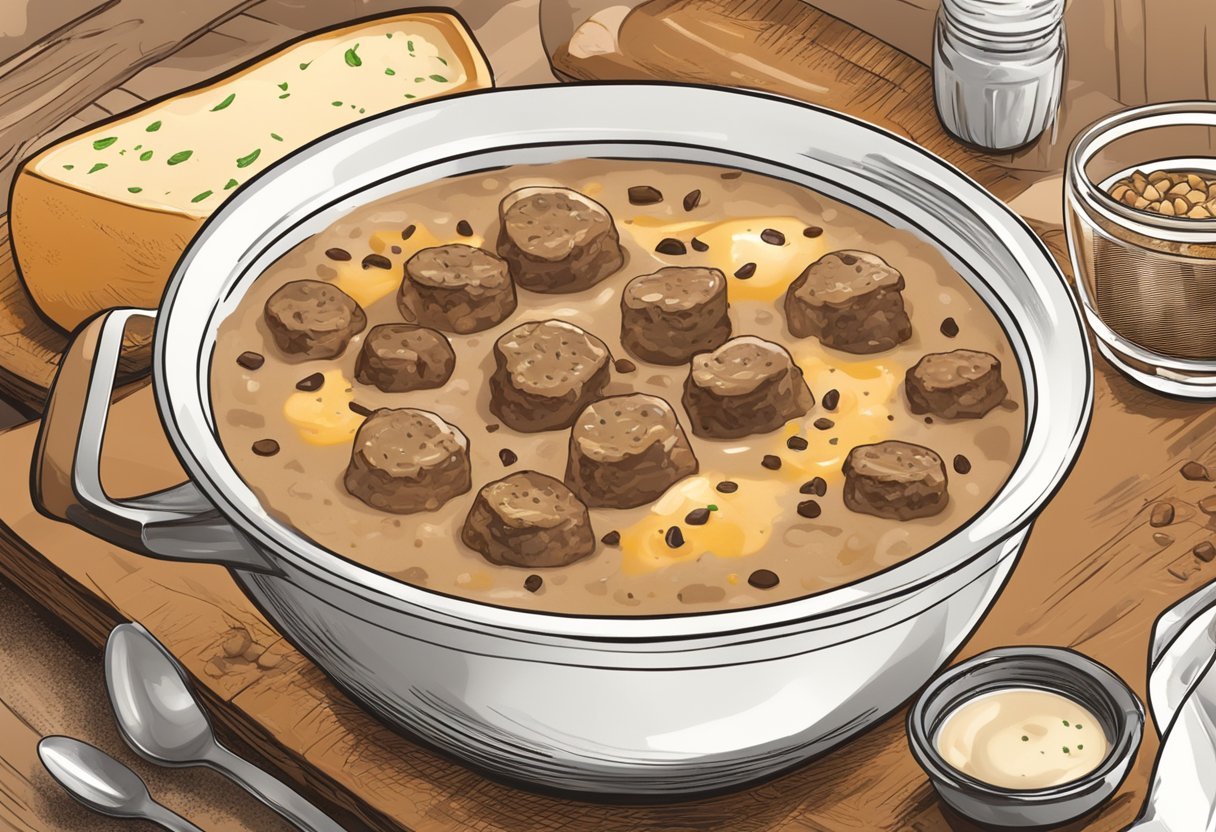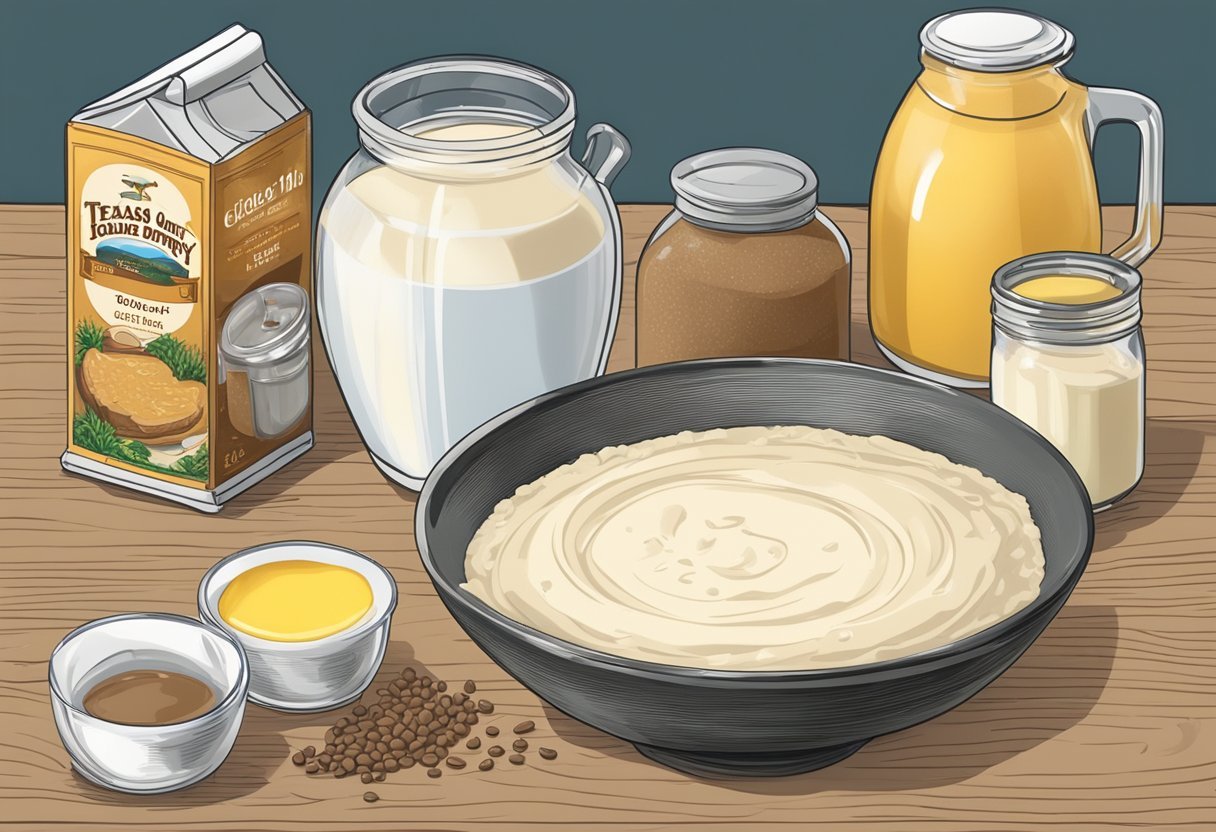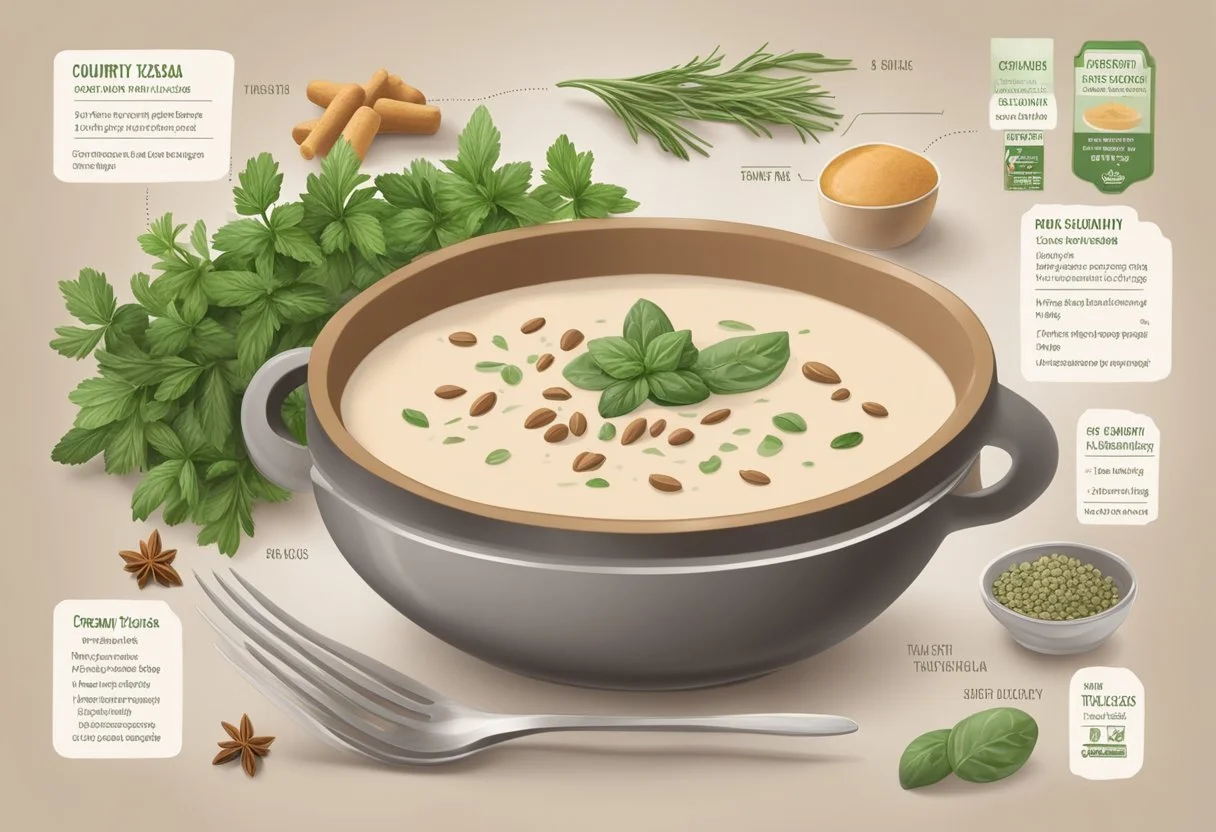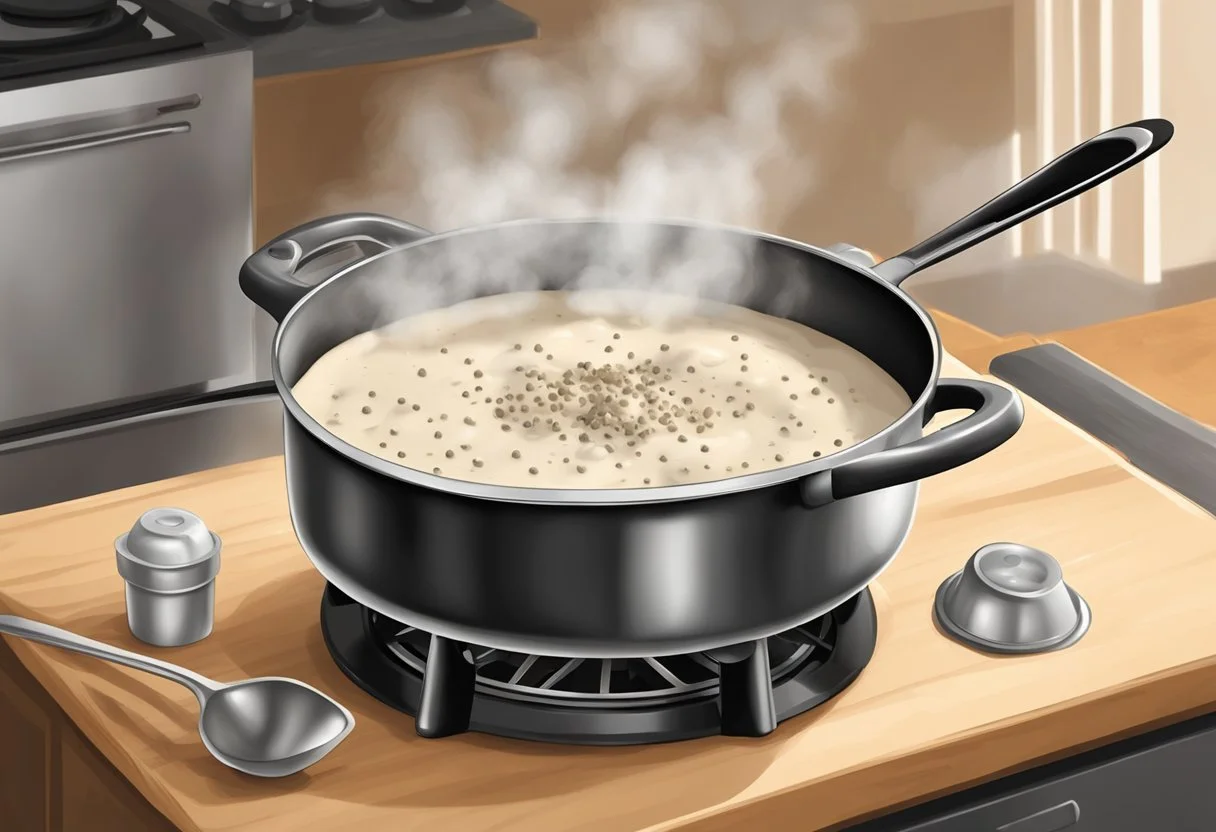Texas Country Gravy
Savory and Simple Recipe Guide
Discover > Truly Texan > Texas Country Gravy
Texas country gravy, a delectable Southern staple, has the power to transform an ordinary meal into something special. With its creamy consistency and savory flavors, this exceptional sauce has long been adored by many as the perfect accompaniment to various dishes such as buttermilk biscuits, fried chicken, and mashed potatoes. Its versatility and rich history make it an undeniably vital part of Texas cuisine.
The origins of this savory delight can be traced back to the rural communities of Texas, where resourceful cooks developed a delicious and satisfying dish that could be crafted using simple, readily available ingredients. Over time, Texas country gravy has evolved, with various regional adaptations and the ability to cater to diverse taste preferences. From its white cream base, embellished with flavors from ingredients such as ground black pepper, and bits of sausage, it's no wonder that this savory sauce holds a special place in the hearts of Texans.
Understanding the art of making and enjoying Texas gravy involves embracing both its historical roots and the ongoing creativity of local cooks who continue to innovate with traditional recipes. A homage to the Lone Star State's unique culinary heritage, Texas country gravy remains a beloved favorite that not only pleases the palate but also provides a tangible connection to the region's rich past.
Origin and History of Texas Country Gravy
Texas gravy, also known as southern white gravy, has its roots in the Southern United States. Its exact origin remains unclear, but it is believed to have been influenced by diverse European, African, and Mexican cooking styles present in the region.
During the 19th century, the southern states of America were mainly agricultural, and people could not afford expensive ingredients. As a result, they learned to make flavorful dishes with simple, affordable ingredients. Texas gravy is one such example with just a few ingredients, commonly flour (how long does flour last?), milk, and grease, which were easily available to the early settlers.
Key Dates and Influences
Early 1800s: The introduction of European (mainly British) cooking styles to the South, which laid the foundation of the southern cuisine.
Mid-1800s: The African influence in the form of cooking techniques, which resulted in the development of a unique cuisine in the South. This could be when the traditional white gravy started being served with classic dishes like biscuits, potatoes, and fried chicken.
Late 1800s: Immigration of Mexicans into Texas. These new settlers might have further shaped the Texas country gravy by merging their own flavors and ingredients into it, such as using more spices to enhance the taste.
Ingredients and Preparation
You can make country gravy by:
Heating grease, oil or unsalted butter (especially bacon (how long does bacon last?) grease) in a pan.
Adding flour to the grease and cooking it until a golden brown roux is formed.
Gradually pouring milk or cream, while constantly whisking, until the desired consistency is achieved.
Finally, it's seasoned with salt, black pepper, and sometimes other spices like cayenne pepper or paprika.
Today, the Texas country gravy has evolved from its humble beginnings and can be found in various forms throughout the region. Its versatility allows it to be served with a wide range of dishes, including chicken-fried steak, mashed potatoes, fried chicken, homemade biscuits, and even scrambled eggs. With a rich history and humble roots, Texas gravy remains a treasured culinary tradition in the Southern United States.
Basic Ingredients and Substitutes
Flavor Enhancers
Texas country gravy typically requires a few basic ingredients: fat, all-purpose flour, milk, salt, and pepper. These ingredients create a rich and creamy sauce with a well-rounded flavor. However, there are several options for enhancing the taste of making gravy if desired:
Fat: Traditionally made with bacon grease or sausage drippings, other options include unsalted butter, vegetable oil (how long does vegetable oil last?), or even rendered chicken or beef fat.
All-purpose flour: This is used to thicken the gravy, but other flours or thickeners like cornstarch (how long does cornstarch last?) or almond flour (how long does almond flour last?) can be used for different textures or dietary preferences.
Seasonings: While salt and pepper are the primary seasonings in gravy, additional spices such as garlic powder, (how long does garlic powder last?) onion powder (how long does onion powder last?), or paprika can be added for extra flavor.
When it comes to getting the best deals, buying vegetable oil, all-purpose flour, salt, pepper, garlic powder, onion powder, or paprika online is the way to go!
Dairy and Non-Dairy Alternatives
The creamy base of country gravy is typically created using whole milk. However, various alternatives can be used for people with dietary restrictions or preferences:
Cooking Techniques
Creating the Perfect Roux
A key element in Texas homemade country gravy is the roux, which serves as the base to thicken the gravy. To create the perfect roux, start by melting your preferred fat (usually butter or bacon grease) in an iron skillet over medium heat. Gradually add an equal amount of flour to the melted butter or fat while continuously stirring with a whisk. This helps prevent the formation of lumps in the gravy. Cook the roux for a few minutes until it turns a light golden brown and smells toasted.
For the most extensive selection, I suggest buying skillet and whisk online!
Achieving Desired Consistency
Once your roux is cooked, it's time to add the liquid ingredients add the milk (typically warmed milk) gradually, while whisking constantly for a lump free gravy. This step helps provide the desired consistency to the Texas gravy.
If the consistency is too thick or thin, there are a few ways to adjust it:
Add more milk in small increments, stirring after each addition.
Lower the heat and cook longer to achieve a thicker gravy.
If you have lumps still, strain the liquid through a fine mesh strainer.
Serving Suggestions
Traditional Pairings
Texas homemade country gravy is a versatile and delicious gravy to add to many Southern dishes. It pairs especially well with the following classic options:
Biscuits: Splitting warm, flaky biscuits and smothering them with white country gravy is a delightful and iconic breakfast staple in Southern cuisine.
Chicken Fried Steak: Chicken Fried Steak as a tenderized beef cutlet, breaded and pan fried, gets an extra layer of flavor when topped with hearty white country gravy.
Mashed Potatoes: Creamy and smooth, mash acts as the ideal base to showcase gravy's rich and savory taste.
Sausage: Whether served on the side or incorporated directly to make a sausage gravy, breakfast sausage delivers robust flavor that complements the dish.
Grits (how long do grits last?): For those who prefer a corn-based accompaniment, grits provide an excellent contrast of texture against the creamy gravy, enhancing both components.
Modern Twists
While Texas white country gravy shines when served with its traditional partners, adventurous cooks and diners can also explore some contemporary variations to elevate their dishes:
Avocado Toast Twist: As an alternative to biscuits, try serving white country gravy atop a toasted slice of sourdough bread layered with mashed avocado for a refreshing, modern touch.
Loaded Gravy Fries: Create an indulgent appetizer by pouring the gravy over crispy seasoned French fries, and garnish with crumbled bacon, cheese, and chopped green onions.
Gravy-Glazed Fried Chicken: For an innovative take on classic fried chicken, drizzle the gravy over the chicken pieces or serve on the side as a dipping sauce.
Country Gravy Breakfast Pizza: Spread a thin layer of white country gravy on pizza dough as the base sauce, and top with scrambled eggs, diced breakfast sausage, cheese, and fresh herbs before baking.
Grits and Shrimp Gravy-Bowl: Incorporate a seafood element by serving sautéed shrimp in a bowl of creamy grits, drizzled with the rich white country gravy for a luxurious and satisfying meal.
Recipes and Variations
Innovative Recipes
While the Classic Texas white gravy is undeniably delicious, there are endless possibilities for creative variations on this Southern favorite. Let's dive into some innovative recipes where traditional ingredients can be replaced or added to, in order to create a new twist on this classic dish.
Spicy Country Gravy: Add chopped jalapenos or a pinch of cayenne pepper to the classic recipe, creating a spicy version of the white gravy. This goes exceptionally well with fried chicken or even in a breakfast burrito.
Mushroom and Onion gravy: Sautee mushrooms and onions in bacon grease, then follow the rest of the classic recipe. This adds deep savory flavors and pairs well with country fried steak or mash.
Herb-infused Gravy: Incorporate fresh or dried herbs(how long do dried herbs last?) like thyme, parsley, or rosemary to the basic recipe for a fragrant twist. This variation is best served with vegetable dishes or roasted chicken. (What wine goes well with roasted chicken?) Remember, the key to a successful country gravy recipe is to experiment and adjust the flavors to your preference. These innovative recipes can inspire you to create a completely unique homemade country gravy that will tantalize the taste buds of your family and friends.
Dietary Considerations and Nutrition
Healthier Substitutes
Homemade country gravy, also known as white gravy, is a delicious comfort food often served with biscuits, chicken fried steak, and mashed potatoes. However, it can be high in calories and fat. The typical serving size (1/4 cup) contains approximately 120 calories and 8 grams of fat. For those who are health-conscious or have dietary restrictions, there are alternatives to the traditional recipe.
One option is to use skim milk or plant-based milk (e.g., almond milk (how long does almond milk last?), soy milk) (how long does soy milk last?) instead of whole milk or heavy cream. This can significantly reduce the calorie and fat content. Additionally, consider using a low-fat or gluten-free flour as a thickening agent to meet specific dietary needs.
Consider incorporating more protein and vitamins into the gravy by adding lean meats such as turkey or chicken. This not only enhances the nutritional profile, but also adds flavor and heartiness to the dish.
Traditional Gravy Healthier Substitute Calories 120 80 Fat 8g 4g Protein 2g 5g Vitamin A 2% 4% Calcium 4% 6%
Allergen Information
It's essential to be aware of potential allergens in homemade country gravy, as it may contain ingredients that can trigger allergic reactions for some individuals. The primary allergens in the classic recipe are dairy (milk) and gluten (wheat flour).
For those with lactose intolerance or a milk allergy, substituting with a lactose-free milk or plant-based milk (almond, soy, coconut) can eliminate the dairy allergen. When dealing with gluten sensitivity or celiac disease, opt for a gluten-free flour blend made from rice, almond, or oat flour (how long does oat flour last?).
In summary, by making simple ingredient swaps and incorporating additional nutrients, homemade country gravy can be made into a healthier and more allergy-friendly option without sacrificing flavor.
Tips and Tricks
Preventing Common Mistakes
When making white gravy, it's important to keep a few key tips in mind to ensure the perfect consistency and flavor every time.
Keep It Simple: Avoid over-complicating the recipe. Use simple, easy-to-find ingredients and follow basic steps to create a delicious gravy.
Flavor: Seasoning is crucial to achieving a tasty gravy. Make sure to taste and adjust the flavor by adding salt and pepper as needed.
Thickness: A properly thickened gravy is key to its texture. Gradually add flour until you reach the desired consistency. Be cautious not to add too much flour, as this can make the gravy too thick.
Temperature: Cook the gravy on low heat to prevent burning and create a smooth texture. If the gravy becomes too thick, add a small amount of milk or water to thin it out.
Storage and Reheating
Knowing how to store and reheat leftover white country gravy can help retain its original flavor and texture. Here are a few guidelines:
Storage: Allow the gravy to cool completely before transferring it to an airtight container. Store it in the refrigerator for up to 3 days.
Reheating: When you're ready to enjoy the gravy again, follow these steps:
Microwave: Transfer the gravy to a microwave-safe bowl and cover with a microwave-safe lid. Heat on medium for 2 to 3 minutes or until heated through, stirring every 30 seconds.
Stovetop: Pour the gravy into a saucepan and gently reheat on low heat, stirring frequently to prevent scorching. If the gravy has thickened too much while stored, add a splash of milk or water to bring it back to its original consistency.
By following these tips and tricks, you will ensure that your Texas gravy remains delicious and enjoyable, even as leftovers.
Pairing Beverages and Side Dishes
When enjoying a satisfying meal with Texas white country gravy, selecting the perfect beverage and side dishes is essential. In this section, various options are presented that will complement the savory flavor of this classic southern meal.
Beverages: A well-chosen beverage can act as a counterpart, balancing the heaviness of the gravy. Light and refreshing options are usually favored. Some recommended pairings include:
Iced Tea: A classic southern choice, unsweetened or lightly sweetened iced tea beautifully complements the richness of country gravy.
Lemonade: The tart and tangy flavor of lemonade works well as a palette cleanser between bites of gravy-enriched dishes.
Light beer: A crisp and cold light beer can offset the heartiness of the meal, without overwhelming the taste buds.
Side Dishes: A well-rounded meal with Texas homemade white country gravy calls for side dishes that enhance its flavors. Some ideal accompaniments for easy white gravy recipe are:
Green Beans: Steamed or sautéed green beans provide a fresh, crisp contrast to the indulgent gravy. Adding sliced almonds (how long do almonds last?) or caramelized onions can elevate this side dish even further.
Skillet Cornbread: The slightly sweet and crumbly texture of skillet cornbread is the perfect sponge for soaking up any remaining gravy on the plate.
Creamy Mashed Potatoes: A classic pairing with country gravy, the velvety smoothness of creamy mashed potatoes marries well with the savory, rich gravy. Consider adding chives or garlic for an extra layer of flavor.
In summary, pairing Texas white country gravy with light, refreshing beverages, and a variety of flavorful side dishes creates a delightful and satisfying dining experience. Utilizing these suggestions will enhance your enjoyment of this classic southern comfort food.
Regional Variations
In the vast culinary landscape of the United States, Texas homemade white country gravy has carved out its space as a distinct and beloved comfort food. As with most recipes, regional variations are bound to arise. Within the borders of Texas, and across the entire Southern United States, adjustments to the traditional recipe have resulted in slightly different versions of country gravy -- some with subtle changes, while others take on an entirely new flavor profile.
One popular variation of white pepper gravy is Sawmill Gravy, which is frequently found in hearty Southern breakfasts. This white gravy is similar in its base ingredients, using fat (usually sausage drippings) and flour to create a simple roux. The main difference between Sawmill gravy and classic Texas country gravy lies in the addition of crumbled sausage and black pepper. Sawmill gravy is often served over biscuits, giving a traditional breakfast dish a rich, spicy kick.
Another common version of white country gravy is milk gravy. This variation relies on milk as the base, as opposed to water or broth. It creates a creamier texture adding a smooth, velvety mouthfeel to the dish. Milk gravy remains versatile, often accompanied by biscuits, fried chicken, or mashed potatoes. While milk gravy is found in several regions, it has a strong presence in Texan cuisine.
Perhaps the most well-known establishment that has brought Texas-style country gravy to broader audiences is Texas Roadhouse, a popular restaurant chain with locations throughout the United States. With their hearty portions and a menu that includes genuine Texas culinary classics, the country gravy at Texas Roadhouse should not be overlooked. Their flavorful and thick country gravy is typically served alongside chicken fried steak, hand-breaded and deep-fried to crispy perfection.
In conclusion, regional variations of Texas country gravy demonstrate the adaptability and versatility of this Southern staple. By embracing different ingredients, methods, and flavor profiles, it ensures that there is a version of this beloved dish to suit the tastes of everyone.






